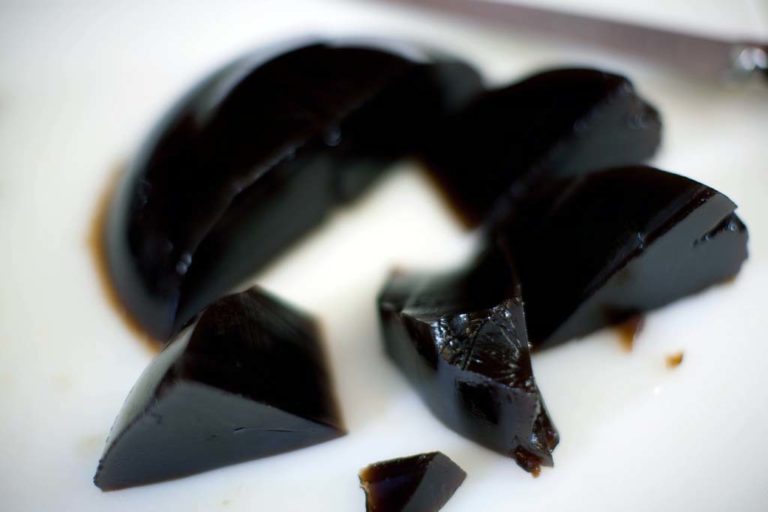
Chef's notes:
Demi-glace (which literally means “half glaze”) is, in its simplest form, a highly reduced brown stock, but not just any brown stock. It is one made from a combination of veal and chicken bones. If you prefer, you can omit the chicken bones and use only veal bones to make brown stock. In this case it would be called brown veal stock (a.k.a. the good stuff). This is what I have done here. Originally, I was going to attempt to resurrect the old recipe for demi-glace that no one prepares anymore—a combination of brown stock and sauce Espagnole. Then I realized that sauce Espagnole wasn’t really bringing anything to the party that couldn’t be added in another way, so I decided to pass on it—at least for now.
Ingredients
- 6 quarts brown veal stock
- 2 cups red wine
- 1¾ cups diced shallot
- ¾ cup diced carrot
- 4 sprigs thyme
- 2 bay leaves
Demi-Glace Made From Reduced Brown Veal Stock, Shallot, Carrot, Herbs, and Red Wine
- Combine the veal stock with the other ingredients. It is not entirely necessary to add anything to your veal stock before you reduce it. However, you can add a couple of things to boost the flavor, and, in my opinion, you might as well. Just keep it simple, as I have here. These items will be removed in step three when we filter the stock.
- Reduce the veal stock by one-third. One way to know when something has reduced by one-third is to measure it. Remember to clean the tape measure before and after. As this veal stock reduces, some scum may float to the surface. It is most likely fat and other stuff that will taste bad in the finished product—remove it.
- Strain and filter the reduced veal stock. Use a metal colander and line it with some cheesecloth. Pour the liquid through the cloth and strain out all the little bits. You can do this multiple times using new cloth each time to get rid of particulates. Use more than one layer of cheesecloth (five or six should do).
- Reduce the veal stock by one-half. Stir the mixture as it reduces and keep an eye on it as it gets close to that halfway mark. At that point you have reduced the original 26 cups down to about eight cups. Demi-glace is a reduction of anywhere between 40 and 20 percent, so you’re right in the middle.
- Pour the demi-glace into a metal bowl and refrigerate. I poured only about half of the demi-glace into the bowl because I wanted to make glace de viande with the rest of it (which I discuss and do in the last step). The demi-glace will take several hours to cool and solidify in the refrigerator.
- Unmold the solidified demi-glace. The demi-glace will stick to the bowl until you warm the edges slightly. Fill a sink with some lukewarm water. Then carefully dunk the bottom of the bowl in the water. It should only take a couple of seconds before the gelatin demi comes loose. Cut into triangles, wrap in plastic, and freeze. Use the demi-glace to make sauces or to add flavor to soups, stews, or anything else that needs a kick in the pants.
- Should you continue reducing demi-glace and make some glace? Well, it takes time, patience, and attentiveness. You literally have to stand there and stir it the whole time. With demi-glace, you have about a 30 percent reduction of your veal stock; glace is a 10 percent reduction. By the time it gets to ten percent, the water is gone and you are dealing with almost pure gelatin. It can burn easily, so stir a lot and keep the heat very low. When it gets to a caramel-like consistency and there doesn’t seem to be any steam coming from the bubbles, it’s done. Pour it into a bowl, cool it, and cut it into cubes. Wrap these cubes with plastic and store them in an airtight container in the freezer. These cubes contain three times as much flavor as demi-glace, so use them wisely. They are kind of like homemade bouillon cubes (except not at all salty and much better).
Tips & Tricks
- You can’t really use commercial stock to make demi-glace because it will become too salty when you reduce it.
- There aren’t a lot of variations for the flavor profile of demi-glace. The only real control you have is what stock you start with. This is okay because you don’t want demi-glace to have too much of any one flavor. Demi-glace is meant to embrace whatever it’s put into, boosting that flavor profile, giving it life.
- Whatever you use to filter the liquid, whether it be cheesecloth or flour sack (which works really well), make sure you rinse it with water and wring it out a couple of times—just in case it has some foreign matter in it.
- As you reduce the veal stock and it becomes demi-glace, you will need less and less heat to continue reduction, so keep lowering the heat as it simmers away.
- Don’t use too violent a boil to reduce the liquid.
- My recipe for demi-glace, although it is a lot different from Escoffier’s recipe, is more similar to it than that of Jus Lié, which is also quite common and basically veal gravy. My demi-glace also has some similarity to Julia Child’s recipe, which she called “semi-demi-glace.”
